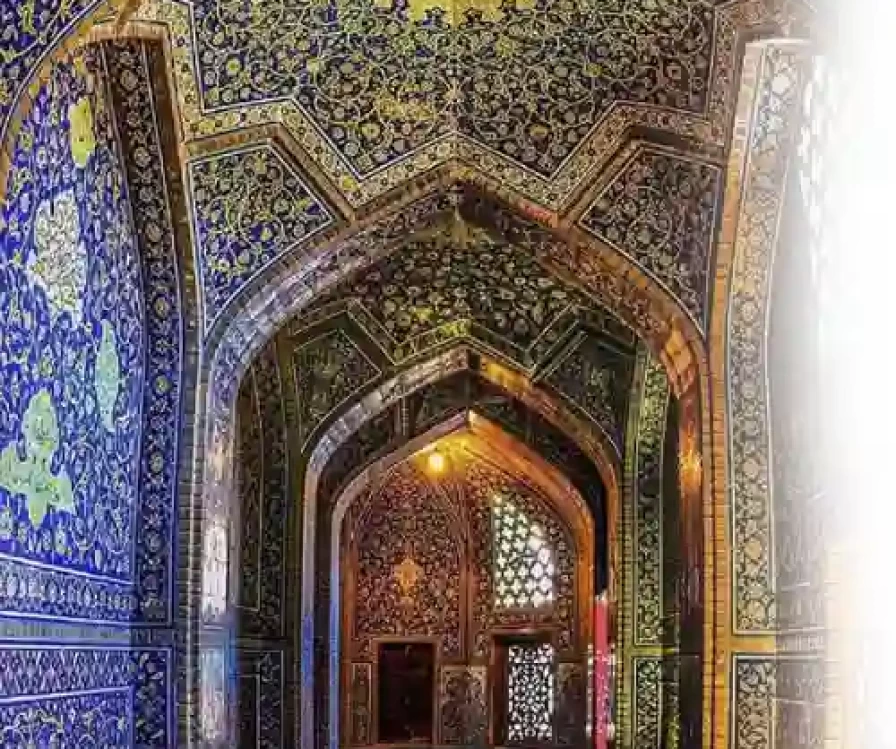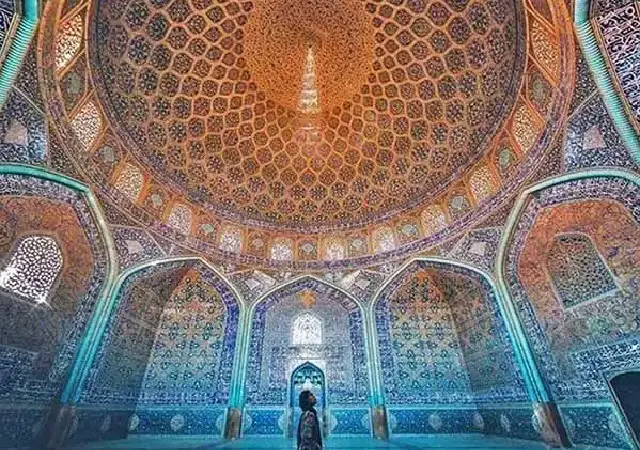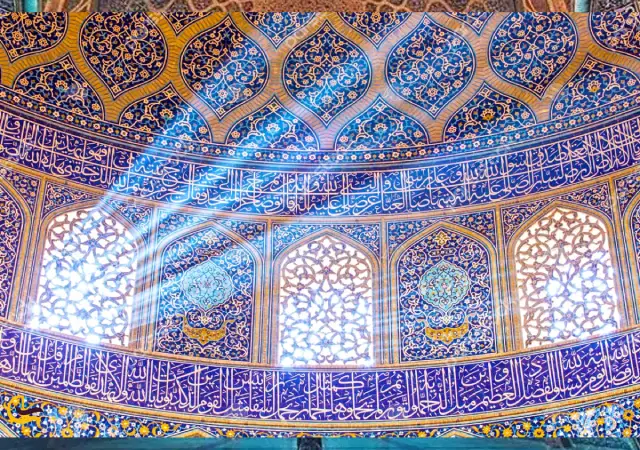
The Miracle of Architecture and Tiling: A Trip to Sheikh Lotfollah Mosque in Isfahan





Sheikh Lotfollah Mosque
The earliest mosque in Islam, during the time of Prophet Muhammad, was remarkably simple. For many years, it was merely a small open area that was later enclosed by walls. The Prophet himself emphasized simplicity, even declining to have a ceiling constructed for the mosque. Most attendees brought simple rugs to sit and eat upon during his speeches. Subsequently, after the Prophet's passing, Muslims began to modify, expand, and enhance mosques, both in size and quality, to better accommodate worshippers, especially during the lengthy Friday prayers. Walls were erected around the mosque, and over time, a ceiling and four doors were added to prevent animals from entering. Initially, the ceiling was made from palm leaves, but later, more durable construction materials were used. Through the centuries, this original mosque evolved into the vast and beautiful structure that stands today in Mecca and Medina, Saudi Arabia, capable of hosting millions of pilgrims annually. When Islam was introduced to the Iranian people, and the majority of society embraced it as the official religion, new Muslims across the country began constructing their own mosques. Today, in every Iranian city, you can find a Jami mosque, a comprehensive facility that often includes separate winter and summer prayer halls, religious schools, temporary and permanent accommodation for pilgrims and students, dining and kitchen facilities for special events like Ramadan, speech halls, and more. Reflecting the needs of a growing Muslim population, these structures sometimes reached enormous proportions, requiring immense financial investment and labor, even by today's standards. One need only look at the Imam Mosque (formerly the Blue Mosque) of Isfahan to grasp the sheer scale of this architectural achievement and the vast resources dedicated to its construction in the 16th century. The Sheikh Lotfollah Mosque , a true gem among Iranian mosques, is situated in Isfahan city, the capital of Isfahan province in Iran. Often referred to as the Sheikh Lotfollah Mosque Isfahan , or sometimes mistakenly as the Blue Mosque (a moniker more accurately applied to the Imam Mosque), the Sheikh Lotfollah Mosque Iran is celebrated for its exquisite deep blue tiles that adorn its entire interior and exterior facade. It stands as an undisputed masterpiece of Iranian architecture throughout history, with its blue tiles being particularly unique in their quality and aesthetic appeal.
Among the numerous beautiful and functional mosques in Iran, the Sheikh Lotfollah Mosque distinguishes itself through its exceptional beauty, prime location, manageable size, functional design, structural solidity, unique sheikh lotfollah mosque architecture , and overall quality of its architectural structure. The color blue has long symbolized wealth and prosperity in Persian society, both before and after the advent of Islam. It evokes the preciousness of water in this arid land and brings a sense of serenity and tranquility to a country historically familiar with invasions and the covetous eyes of neighboring and distant lands. As a place of prayer, the blue hues within the Sheikh Lotfollah Mosque interior foster a calm atmosphere conducive to contemplation for those following the Imam's voice. This color promotes tranquility and enhances the spirituality of the mosque's interior. Stepping inside Sheikh Lotfollah Mosque , one can immediately sense this profound spirituality. The interior of the Sheikh Lotfollah Mosque is completely covered in genuine blue tiles that retain their original brilliance even today. The interior dome, too, is adorned with colorful tiles to such an extent that not a single square centimeter is left unembellished, showcasing genuine enameled blue and green hues. The entire structure exudes a sense of solidity, unity, and profound spirituality.
The dome of the Sheikh Lotfollah Mosque dome features a double-vaulted construction. The expansive exterior dome provides ample space to accommodate a large number of worshippers, both pilgrims and locals. However, for architectural and aesthetic reasons, as well as for insulation, a smaller interior vault was added to the prayer hall. This ingenious design, developed by master architects during the 16th century and before, was widely adopted in the construction of large mosques. The space between the two vaults could be substantial, sometimes creating seven to nine rooms, which architects occasionally utilized for added functionality. This space not only increased the structure's size and utility but also provided excellent insulation against extreme temperatures, effectively serving as the mosque's ceiling and moderating the interior climate.
Imagine the stark contrast between the scorching desert heat, often exceeding 50 degrees Celsius, and the remarkably temperate atmosphere within the mosque. Similarly, during the freezing Isfahan winters, with temperatures dropping below zero, the interior of the winter prayer hall remains sufficiently warm for comfortable prayer. The thick walls of the entire structure are not only capable of supporting the heavy double-vaulted dome but also contribute significantly to the building's overall solidity. These thick walls, constructed from mud bricks, provide excellent insulation against both the intense summer heat and the frigid winter cold, effectively mitigating the significant daily temperature fluctuations characteristic of the desert climate. Visiting inside Sheikh Lotfollah Mosque today, even in the depths of winter, reveals a surprisingly comfortable interior, and conversely, during the summer's heat, the inside temperature remains noticeably cooler than the outside.
Within the interior vault, entirely covered in vibrant tiles, a large and beautiful peacock in various colors and golden shades, with a magnificent tail also highlighted in gold, can be found. Opposite the tail is a tiled window with a carefully placed opening that allows sunlight to stream in, illuminating the peacock and its tail with a soft and ethereal light. As the day progresses and the earth rotates, the angle of light penetrating the dome's interior shifts, much like the hands of a wristwatch, effectively indicating prayer times. When the light rays fall directly on the center of the peacock's tail, it signifies exactly noon, the time for the noon prayer. At this signal, the " moazin " the person responsible for announcing prayer times by chanting from the mosque's tall minarets, calls the faithful to prayer, alerting the entire community, and Muslims hasten to the mosque for their noon prayers. Through experience, they could also discern the times for the afternoon and evening prayers based on the changing angles of sunlight. Beneath the main prayer hall is a basement used for additional worshippers and for congregations during regular and special events throughout the year. Some evidence suggests it also served as a social and political gathering hall for speeches. A long and wide channel once connected the royal palace to this basement prayer hall, allowing the king and other noblemen to travel between these important political locations discreetly, unseen by ordinary people or spies. This secret interconnected passage remained largely unknown until recently.
The Isfahan Sheikh Lotfollah Mosque , situated within the renowned Imam Mosque complex in Isfahan, is a major draw for tourists visiting the city. Established during the Safavid era, the Sheikh Lotfollah Mosque Isfahan Iran stands as a jewel among all Safavid mosques and is rightfully considered one of the most splendid architectural achievements of the entire Islamic era. The importance of visiting the mosque cannot be overstated for tourists coming to Iran. Missing a visit to the Sheikh Lotfollah Mosque Iran is truly a significant oversight. While visiting other Safavid mosques is rewarding, experiencing the Sheikh Lotfollah Mosque , sometimes referred to as the Blue Mosque (though this name is more accurately associated with the Imam Mosque in Isfahan ), is an entirely different experience. The indescribable shades of blue on its tiles and enamels, and the golden hues of the peacock's tail within the dome's interior, are truly unforgettable. To understand the significance of this site, one need only examine Sheikh Lotfollah Mosque photos . If you miss it, you might indeed never forgive yourself. Sana Persian tour and travel service provider one of the best Iran travel agency anticipates welcoming you to Isfahan soon.
Contact Us
+989054577261